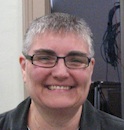Undergraduates in the Archives – Taraba 1
February 2012
1How have you worked with undergraduates in archives and/or special collections?
Suzy Taraba
Head of Special Collections and University Archivist – Wesleyan University
¶ 1 Leave a comment on paragraph 1 0 Since I came to Wesleyan nearly fifteen years ago, a key focus of my job has been outreach to the faculty, and thus the undergraduates, through the curriculum. To this end, I teach thirty-five to fifty class sessions each academic year in Special Collections & Archives (SC&A). Disciplines range from astronomy to writing, and just about everything in between.
¶ 2 Leave a comment on paragraph 2 0 Though all class sessions have the common goal of raising undergraduate awareness of and interest in the holdings of SC&A, each class presentation is different, based on both the subject of the course and the pedagogical purpose for which the materials will be used. Some sessions take a classic “dog and pony show” approach in which I, or sometimes the professor and I, present a group of interesting materials from our collections and talk briefly about each item, how it connects to the course, and/or how it might be used in the students’ research. In other sessions, students take a more active role by doing an in-class assignment. One such assignment we often use is the “mystery book exercise” that a History of Science faculty member and I developed together. “Mystery book” is a fun, fast-paced exercise that trains students to evaluate an unfamiliar source quickly and teaches information-literacy skills using books or documents connected to the subject of the course. After spending a few minutes looking at a book they have not seen before, students answer ten questions, which range from the (usually) easy identification of the author to more complex considerations of how the mystery book might inform their research. Still other classes use the visit to SC&A to prepare for an in-depth paper or project that requires, or at least strongly encourages, the use of materials in SC&A. These longer assignments are as varied as the classes, and they include traditional term papers, documentary editing projects, artists’ books, and creative writing based on primary sources, among others. For the full list of mystery book questions, other assignments, and comments from Wesleyan professors who use SC&A in teaching, see the online exhibition, Old Books, New Pedagogy: Special Collections and Archives in the Curriculum.
¶ 3 Leave a comment on paragraph 3 0 Of course, not all the work I do with undergraduates is teaching them about archives and special collections in class settings. Often class visits spark students to use SC&A for other courses, senior theses or essays, co-curricular activities, or just simple personal interest. In many of these cases, I work one-on-one with the students to help them identify relevant materials, focus topics, find related books or documents, and understand the context, all of which are typical functions of reference and instruction librarians.
¶ 4 Leave a comment on paragraph 4 0 Much of my recent professional activity has focused on teaching undergraduates to use archives and special collections. I have just co-edited a volume of case studies on this topic, entitled Past or Portal? Enhancing Undergraduate Learning through Special Collections and Archives. The book, which was recently published by the Association of College and Research Libraries, contains nearly fifty real-life examples of undergraduate curricular uses of archives and special collections in a wide variety of institutions.


0 Comments on the whole post
Leave a comment on the whole post
0 Comments on paragraph 1
Leave a comment on paragraph 1
0 Comments on paragraph 2
Leave a comment on paragraph 2
0 Comments on paragraph 3
Leave a comment on paragraph 3
0 Comments on paragraph 4
Leave a comment on paragraph 4